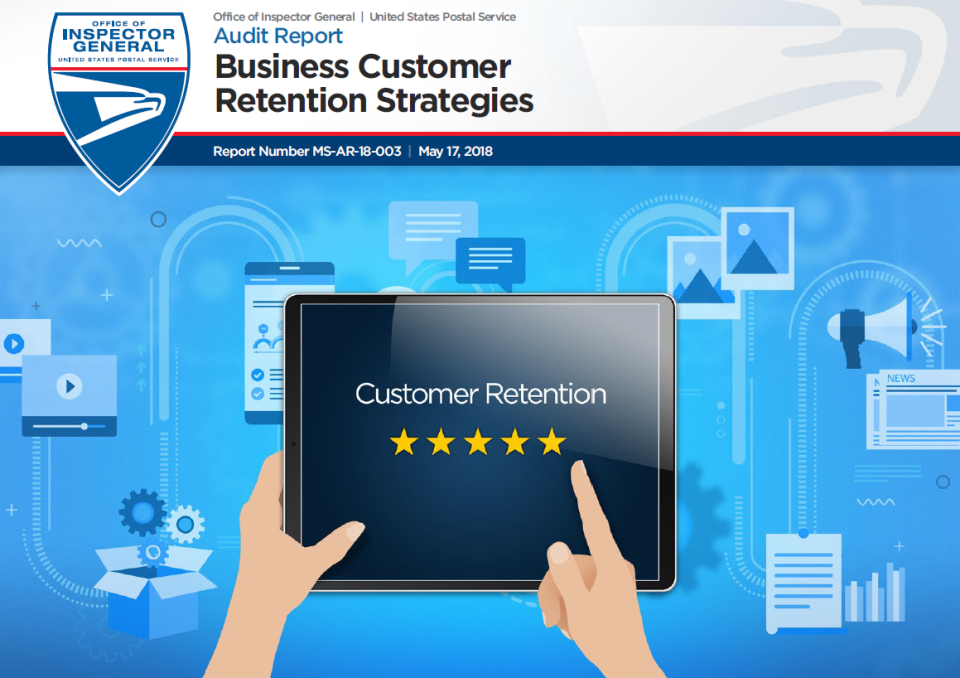Business Customer Retention Strategies
Objective
Our objective was to assess the effectiveness of the U.S. Postal Service’s business customer retention strategies.
The Postal Accountability and Enhancement Act of 2006 was enacted at a time when mail was a primary vehicle for advertising, correspondence, and business transactions. Since that time, consumer behavior and the marketing industry have significantly changed. Digital advertising, electronic bill pay, and email correspondence have impacted mail volume, resulting in a 40 and 24 percent decline in First-Class and Marketing Mail volume, respectively, since 2006. In fiscal year (FY) 2017, First-Class Mail volume declined by 2.5 billion pieces and Marketing Mail volume declined by 2.6 billion pieces, primarily due to digital diversion.
In FY 2012, the Postal Service’s Business Customer Intelligence group in Sales and Customer Relations developed a mitigation plan and implemented customer retention strategies for business customers with partial revenue or total revenue loss. The Postal Service defines customer “churn” as partial revenue lost from a customer during the analysis period, while “defection” is defined as total revenue lost from the customer. Management can measure churn and defection by the amount of revenue the Postal Service has lost from these customers.
We issued a report in September 2014 recommending the Postal Service enhance the effectiveness of its customer retention efforts. Since that time, the Postal Service has expanded its business customer retention programs, which now include Small Business Campaigns, Select Business Account Management, and Strategic Service Support. These expanded retention efforts include:
- Dedicated employees at 12 customer retention team (CRT) sites.
- Predictive analytics through historical data analysis.
- Proactive campaigns targeting at-risk small business customers.
- Ongoing customer surveys to identify reasons for churn and defection, as well as customer expectations.
The Postal Service implemented these programs to proactively identify at-risk business customers before churn or defection occurs.
What the OIG found
The Postal Service’s proactive business customer retention strategies have been effective in reducing churn and defection. From FYs 2015 to 2017, the Postal Service’s retention efforts reported a significant financial benefit, with retained revenue of over $1.8 billion using dedicated retention employees, predictive analytics, proactive targeted campaigns, and customer surveys.
However, the Postal Service could enhance its mitigation plan to address certain operational and administrative challenges. Specifically, the plan did not address:
- Delivery quality, convenience concerns, and customer service problems for small business customers. [Redacted.]
- Supervisory turnover at CRT sites. These sites experienced frequent turnover as these 2-year temporary positions have led all CRT supervisors to actively seek other opportunities.
- CRT employee evaluations. Management did not evaluate CRT employees based on specific measurable performance goals related to churn and defection.
These conditions occurred because:
- There was no formal mechanism in place to communicate churn and defection data with the functional operational areas responsible for implementing service improvement, including Delivery and Retail and Customer Service operations.
- Management did not agree on the supervisory structure at the CRT sites.
- Management did not establish CRT employees’ individual goals or performance metrics due to CRT sites still becoming fully staffed and trained.
We estimate improvements to the Postal Service’s retention strategies could have prevented [redacted].
In other matters, certain external challenges also impacted churn and defection. For example, the Postal Service has been unable to incentivize volume through the use of promotions, as all promotions expired as of December 31, 2017. New promotions require Board of Governors approval and, until Board members are appointed, such promotions cannot be offered. In FY 2017, the Postal Service mailed 16 billion pieces of promotions mail valued at a total of $648 million. Lastly, the Postal Service does not have the flexibility to offer new nonpostal services due to legislative restrictions. Proposed legislation which has been pending since January 2017 would address some of these restrictions.
What the OIG Recommended
We recommended management update the mitigation plan to include a mechanism to provide churn and defection data to operational areas, re-evaluate and address the customer retention team site supervisory structure; and establish customer retention team employee goals and performance metrics.

